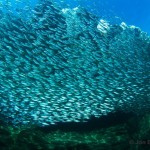In 1872, the instructions to the captain of the HMS Challenger, the first dedicated global exploration of the oceans, read explore “all aspects of the deep sea…You have a wide field and virgin ground before you.”
Nearly 100 years later, C.P. Idyll notes in his forward of Abyss: The Deep Sea and the Creatures that Live In It
“The planet earth is still largely unexplored. Nearly 3/4 of its surface covers a vast region that is almost unknown to man.
This is the domain of the sea.
Of the 197 million sq. miles of the earth’s surface, 139 million sq. miles are covered by the world ocean…White seas, and all the rest. 71% of the world is ocean. Of that, [90%] is more than 200 meters in depth. This is the abyss, the “deep sea,” and it covers almost 2/3’s of the earth’s surface.
Event these figures do not reflect the true immensity of the world of water. Remember that the oceans are three-dimensional, averaging 2.4 miles in depth…
Man has really only begun to look into the depths. We have fished a small part of it and we have dipped our scientific instruments into it in a tentative way, probing it with electronic fingers, testing the bottom with dredges and drills-like a child wetting his toes at the beach.”
When I started in 1998 on a graduate career in deep-sea biology, I began with visions of Alvin dives and a picture of Sylvia Earle on my desk. Gage and Tyler’s landmark book on deep-sea biology had only been out a few years, and I engulfed its words on the extent of what was known about this habitat. Our knowledge had grown immensely since Challenger and Idyll, yet there was an open field with many questions before me. Now at the end of 2006, as Peter and I make our move to Science Blogs, I am struck again with the dichotomy of what is known and unknown. As each day advances, this remote environment becomes less remote. Our knowledge moves ahead so quickly, there is enough to fill the pages here and cause Peter and I to scramble to cover it all for you.
More importantly, I am struck by how much we don’t know what we don’t know. Deep-sea animals continue to awe us with their adaptations to the extremes of this environment. Explorations of uncharted regions of the abyss reveal new ecosystems we never knew existed. Both challenge our views on the limits of life and habitable areas.
So as our knowledge and questions mature, you can view it here.
This is a blog, a journal, a dialogue on the deep sea.





Welcome, Steve and Peter!
FWIW, I used to watch a lot of science shows when I was a little kid. Many of them were about the deep ocean. (It was the early ’80s, and I think that PBS was a little bit in love by the new possibilties in underwater photography.) I recall having the same relationship to those uder-sea moving pictures that some kids probably had to horror movies: they both thrilled and scared me. I couldn’t stop looking at the brain corals, the barnacle- and seaweed-encrusted hulls of sunken ships, the waving fronds of kelp. It looked cold in there, and dark, and…strange. But I couldn’t stop watching.
So I’m looking forward to reading and having you shed some light on a place I’ve long found intimidating and fascinating.
Deep-sea biology? I think I
Hooked is that a pun! Thanks for the nice welcoming Katherine.